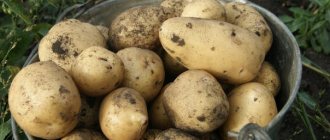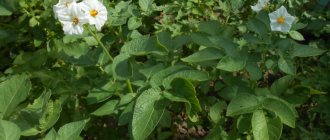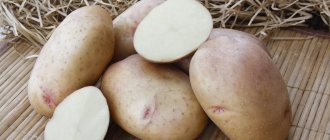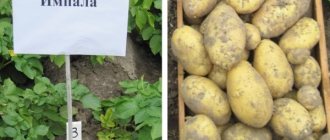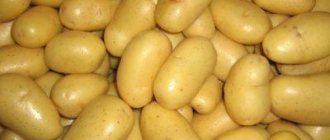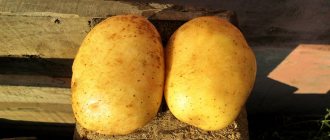Latona potatoes are another creation of Dutch selection. The variety has been on the table for quite a long time, as it was bred in the early 90s. Latona was developed by scientists from. In 1996, Latona was included in the State Register of the Russian Federation. Recommended for cultivation in the following regions:
- North-West.
- Central.
- Central Chernozem.
The article will contain a detailed description of the variety, photos of Latona and reviews from farmers who are familiar with this Dutch potato first-hand.
Characteristics of the variety
Latona potatoes are an early ripening table variety. Once in the ground, the tubers ripen in 65-80 days.
The variety is suitable for both commercial cultivation and cultivation in summer cottages. The yield is high, reaching 460 centners per hectare.
The tubers are yellow, the flesh is light yellow. The average weight of a mature fruit is 90-110 g. There are specimens up to 140 g.
Latona boiled potatoes. It is not suitable for frying, as it contains 16-20% starch. Its quantity is affected by the quality of the soil. The more nutritious it is, the higher the percentage of starch.
Latona responds adequately to drought and high humidity, although under the latter conditions it can easily contract late blight.
Immunity is average. It does not protect the tops from late blight, but moderately protects the tubers from this fungus. Latona is also afraid of common scab.
Potatoes Antonina: variety description
In 2005, the variety was included in the register of those approved for cultivation. The originators are the Siberian Scientific Center for Agrobiotechnologies of the Russian Academy of Sciences and the All-Russian Research Institute of Potato Farming named after. A. G. Lorkha. The variety combines decent taste with resistance to diseases and many unfavorable environmental conditions.
Ripening time and yield
The Antonina potato variety is an early variety and has a short growing season. Between the time of planting and harvest, usually 60 to 70 days pass. The first digging can be done 45 days after the crop produces its first shoots.
Potato variety Antonina
Productivity indicators are superior to many similar varieties. The average yield of Antonina potatoes varies from 210 to 300 centners per hectare. The maximum yield is 425 centners per hectare.
Disease resistance
In practice, the crop demonstrates resistance to diseases such as potato cancer. At the same time, he is vulnerable to some diseases:
- late blight of tubers and tops;
- golden potato cyst nematode.
Characteristics of tubers, description of appearance
The bushes of the plant are tall, semi-erect, leafy. The color of the leaf blades is green, the sizes are from medium to large. The edges are wavy. The corollas are white, medium and large.
Tubers are oval shaped. The number on the bush is from 6 to 10 pieces. Covered with a slightly rough yellowish peel. Their average weight is from 100 to 150 g. The depth of the eyes on the tubers is average. The pulp is pale yellow in color.
Appearance of tubers
For which regions is it suitable, climate requirements?
Antonina potatoes are an example of unpretentious plants suitable for growing in harsh conditions.
The culture is resistant to adverse weather conditions. The summer season in Siberia and the Urals is very short, with late returning frosts and cold snaps at night already in August. The Antonina variety, even in such a climate, manages to produce a good harvest in a short summer.
Positive and negative sides
Latona is very popular among gardeners due to a number of its advantages. These include:
- Relatively fast ripening period. You can dig potatoes for testing 45-50 days after planting.
- High yield. Table varieties rarely impress with their yield, which cannot be said about Latona. Under favorable conditions, you can easily cultivate up to 460 quintals from 1 hectare of plantings.
- Drought resistance. The variety is not afraid of short-term droughts.
- Easy to grow. Latona is not demanding in terms of care and is not picky about the type of soil.
- Resistance to mechanical damage. This property allows you to easily transport the harvested crop over long distances.
At the same time, there are a number of disadvantages. Firstly, the variety is very starchy, which makes it less versatile in terms of preparation. Secondly, Latona has a relatively weak immune system, which requires additional care measures.
Correct fit
Potatoes begin to be planted after the soil has warmed to a temperature of +9-10 degrees Celsius. At lower temperatures, tubers develop more slowly or even die.
High-quality seed material is selected for planting. Tubers should not have defects in the form of cracks, spots, rot, etc. Also, it is not recommended to divide the tubers into parts. It is advisable to plant whole root crops of medium weight (60-70 g).
Planting holes are made no deeper than 10 cm. If the soil is rich in nutrients, additional fertilizing is not necessary. If the soil itself is poor and has a heavy structure, you will need to apply “direct” fertilizing directly into the hole. Before placing the tuber in the hole, a handful of wood ash or humus is poured into it.
When planting, it is necessary to maintain the distance between the rows and holes. The denser the planting, the greater the risk of disease and the more difficult the further care process (in particular, hilling). The distance between rows is 60-70 cm, between bushes - 35-40 cm.
Features of growing Latona potatoes
Latona potatoes do not require special attention, as they are an unpretentious variety. In any case, in order to reap a good fruitful harvest, a number of works need to be done.
How to choose the right place
In this regard, Latona potatoes are absolutely no different from other varieties - the area must be sunny; shade will prevent the timely development of tubers. It is absolutely necessary to follow the rules of crop rotation, this will help avoid potato contamination with various diseases. Excellent predecessors for the site will be legumes, cucumbers, cabbage, and beets.
Soil requirements
When choosing soil, the Latona potato variety is also not whimsical; it can grow even in the most unfavorable soil, but if you want to harvest as much crop as possible, and its taste and product characteristics are excellent, then you should choose light, loose, fertile soil. Even if the soil is bad, applying fertilizers and a number of agricultural works will allow you to grow a wonderful harvest. Take care of preparing the site in the fall; to do this, clear it of weeds, apply fertilizer, and the soil needs to be dug up or plowed.
What are the landing times?
We start planting Latona potatoes only when the soil has warmed up to at least + 10 degrees, and spring frosts are behind us. This time falls around mid-May, but focus specifically on your region.
Preparing to plant Latona potatoes
Potatoes Latona: photo of variety
Latona potatoes, like any other potato variety, require preliminary preparation before planting:
- the first thing to do is to sort through the seed potatoes, discarding rotten, damaged, deformed material; only healthy, strong tubers are required for planting;
- Then the potatoes are disinfected by treating them with special preparations or a solution of potassium permanganate, which makes it possible to prevent diseases and pest attacks. Also, seed potatoes can be treated with growth stimulants, which will have a positive effect on its further growth and overall yield.
How to plant Latona potatoes correctly
If the field is plowed, the soil has warmed up, and the Latona seed potatoes have been processed, we begin planting them. To do this, the most popular scheme is used - holes are dug about 10 cm deep, the distance between them is about 45 cm, and the row spacing should be about 70 cm (since this variety is tall, this distance will help avoid “darkening” the neighboring bushes). Planting material is placed in the holes, after which it is all covered with earth.
Care
Latona potatoes are no more demanding than any other potato varieties. To get a good harvest, it is enough to follow a number of simple agrotechnical rules:
- You can grow potatoes even without watering. But still, to get a better harvest, it is advisable to carry out at least 2 waterings per season. The first time during the formation of flowers, and the second time after they disappear.
- It is not recommended to water potatoes before the tops appear, nor is it recommended to water potatoes after flowering. Secondly, the risk of late blight increases, to which Latona has no immunity.
- Fertilizer application should be moderate. In the case of potatoes, an abundance of organic matter can only do harm. Thus, when fertilizing potatoes, it is undesirable to use nitrogen-containing fertilizers, especially in the active phase of development.
- In any case, potatoes will be affected by the Colorado potato beetle. For this reason, it is necessary to systematically inspect the bushes for the presence of these parasites. If larvae, eggs or adults are identified, collect them manually or use special chemistry.
- Carry out hilling. This is the most important agrotechnical procedure, which many neglect. But in reality, hilling allows you to increase productivity by 20-30%. This is due to the fact that it performs a number of functions: saturates the soil with oxygen, loosens the soil, removes weeds from the site, and supports the tops from falling to the ground.
- Two weeks before harvesting, the tops are mowed in order to speed up the ripening of the tubers.
Advantages and disadvantages
The advantages and disadvantages of Latona potatoes are well covered in reviews from vegetable growers. Based on the skill of potato growers, you can create a visual table.
Resistance of potatoes to impacts, scratches and so on, ability to mechanical planting, maintenance and harvesting.
The variety admires scab.
Short growing season.
If harvested untimely, the skin on the tubers becomes very rough.
Capable of long-term transportation.
Good tuber growth throughout the season due to the gradual death of the tops.
Resistance of the Latona variety to climatic changes
High shelf life, the harvest during storage is saved by 97%.
In order to get a large harvest, Latona potatoes are planted taking into account the requirements of crop rotation. The variety grows well after cabbage, legumes, root vegetables and pumpkins. But tomatoes or peppers are undesirable predecessors.
There are three main ways to plant potatoes:
All three are equally suitable for the Latona variety. Gardeners choose which option to plant “Latona” depending on the climate and soil composition.
- The trench method consists of digging ditches into which prepared potato tubers are then spread. The depth of each trench is 15 cm, and the distance between adjacent trenches is 70 cm. Seed potatoes are placed at a distance of 35-40 cm from each other, then sprinkled with soil. The method is excellent for sandy, light soil that does not retain moisture and for regions with warm climates.
- The smooth planting method is best known to amateur potato growers. In this case, the earth layer is raised, the potatoes are laid with their sprouts up and sprinkled with soil. This solution is suitable for areas where there is no stagnant water and excellent lighting. “Latona” can maintain a distance of 70 cm between tubers; they are planted in two rows like chess. Planting depth – 10 cm.
- The ridge planting option is selected for heavy soil with excess moisture. The earth is raised to a height of 15 cm in the form of a mound. The suitable distance between ridges is 70 cm, between potato bushes 30 cm.
Pre-planting preparation of tubers is certainly carried out - germination, treatment against pests and diseases. For processing, gardeners use preparations such as Albit or Maxim. The product is used as indicated in the instructions.
If there is such a danger, you need to calculate the possibility of draining the area.
At the time of digging, add manure, humus, min. fertilizers
For Latona potatoes, the best planting time is early May. The ridges are located from the north to the south.
After planting, standard care measures are provided for potato beds. The Latona variety responds very gratefully to the careful fulfillment of agrotechnical requirements. If you give it a lot of attention, the yield rises to the highest level. The most important stages for caring for Latona potatoes are watering, loosening, hilling, fertilizing, and prevention from pests and diseases.
Watering is most useful at the time of bud formation and flowering of the bushes. At other times, potatoes do not require constant moisture. For the variety, focal watering and sprinkling are used.
What can you do to make cut roses last longer in a vase? What varieties of roses last the longest in a vase when cut? How to properly add sugar, vodka, aspirin to the water in a vase to make living roses last longer?
Weeding the beds. A necessary event for potatoes. The beds are weeded for the first time seven days after planting.
Fertilizing is combined with watering.
Preventive measures in order to prevent the occurrence of diseases and pests must be taken constantly. Potatoes of the Latona variety should be protected from the invasion of the Colorado potato beetle, which can cause great damage to plantings.
Hilling and feeding
Regarding the hilling of the Latona variety, gardeners do not have the same opinion. But you need to take into account the climate conditions and soil composition on the site. When hilling potatoes in the middle of the nest, the temperature increases. When it can reach +20°C, tuberization slows down. For this reason, some people consider this procedure unusable. But hilling is necessary in order to protect the potatoes from the expected cold snap, accumulate moisture and stimulate the growth of tops. This greatly increases productivity. The first time Latona potatoes need to be hilled when sprouts appear. After watering or rain. It is important to carry out hilling before flowering.
It is most advisable to feed a potato variety with mixed fertilizers. For potatoes, it is necessary to change mineral and organic nutrition.
How to feed Latona potatoes:
- When planting, add 1 tbsp. a spoonful of nitrophoska in each well.
- At the moment of green mass collection, add semi-liquid mullein or a composition of 1 tbsp. spoons of urea in a bucket of water. 0.5 liters of any fertilizer is enough.
- During the budding period, you need to feed the potato bushes with potassium. Wood ash (3 tbsp) and potassium sulfate (1 tbsp) in a bucket of water are suitable.
- In the flowering phase, granular superphosphate is used.
Latona diseases
As noted earlier, Latona is not protected from scab and late blight.
Late blight
This is one of the most dangerous diseases. Moisture and heat promote the spread of this fungus. As a rule, the main peak of late blight activity occurs at the beginning of summer, approximately 1.5 months after planting potatoes.
During late blight, rapidly developing dark spots appear on the leaves and stems. If you do not take any measures, then you can simply say goodbye to the harvest, since the fungus spreads by spores, infecting more and more healthy bushes in a short time.
Disease prevention measures:
- One of the causes of late blight is high humidity. If you do not neglect watering, the risk of infestation by this fungus is minimized.
- Mowing the tops helps not only speed up the process of tuber formation, but also protect the crop from tops late blight.
Common scab
This fungus infects tubers, which leads to loss of marketability and taste. The tubers become bland in taste, are not stored for a long time and completely lose their presentation.
We recommend reading: “Description of the Khozyayushka potato variety”
It is difficult to combat this disease, since in the initial stages it does not manifest itself in any way and does not invade the surface part of the crop.
Disease prevention measures:
- As a preventive measure, before storing planting material, it is treated with Polycarbacin. The treatment is repeated 2 weeks before planting the tubers in the ground.
- The fungus thrives best in alkaline soil. Therefore, preventive measures should be aimed at lowering the pH level.
Harvest and storage
Potatoes for summer consumption are harvested according to culinary needs or market demand. In the first half of summer, vegetables have not yet reached their maximum size. For consumption in autumn and winter, the tubers are collected when they are ripe, when the bushes turn yellow and become dry.
How and when to collect
Most often, Latona potatoes are grown for early harvest. Therefore, it is dug early, when the tubers reach a weight of more than 30 g, and the peel is still peeling off. Vegetables are harvested at the end of June or beginning of July. During this period, the bushes fade and begin to fade.
In the north, the harvest is harvested in the last ten days of September. The potatoes are dug up carefully, supporting the bushes on the side of the ridge with a pitchfork. The plant is pulled out by the tops, the tubers are collected and placed in buckets.
Storage features and keeping quality of the variety
Potatoes for storage are sorted and dried in the sun for no more than 2 hours. The crop is kept in a room with an air temperature of about +5°C and a humidity of no more than 90%. Most often, potatoes are stored in wooden boxes, bags, nets in the basement or cellar.
Vegetables are placed in boxes with small holes. The layer should not be more than 50 cm so that the lower fruits can be saturated with oxygen and excess moisture can evaporate. Containers with the harvest are placed on pallets or planks, leaving a small distance from the wall.
Every month the condition of vegetables is checked and spoiled fruits are promptly removed. The room is periodically ventilated. Latona has a high shelf life - 90%, if there is no condensation at the storage location.




